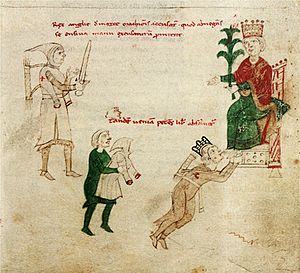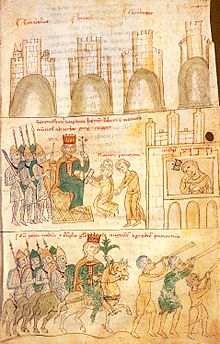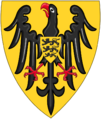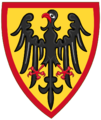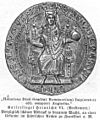Henry VI, Holy Roman Emperor facts for kids
Quick facts for kids Henry VI |
|
|---|---|
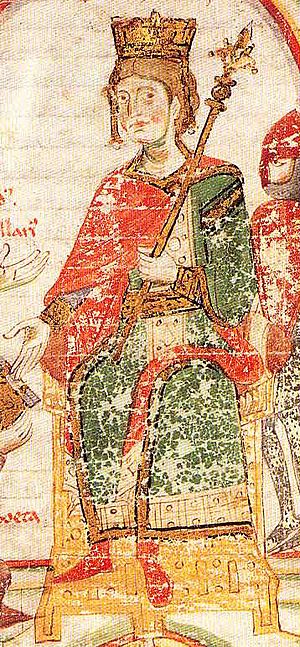
Contemporary portrait from the Liber ad honorem Augusti, 1196
|
|
| Holy Roman Emperor | |
| Reign | 15 April 1191 – 28 September 1197 |
| Coronation | 15 April 1191, Rome |
| Predecessor | Frederick I Barbarossa |
| Successor | Otto IV |
| King of Germany (King of the Romans) | |
| Reign | 15 August 1169 – 28 September 1197 |
| Coronation | 15 August 1169, Aachen |
| Predecessor | Frederick I Barbarossa |
| Successor | Philip and Otto IV |
| King of Italy | |
| Reign | 21 January 1186 – 28 September 1197 |
| Coronation | 21 January 1186, Milan |
| Predecessor | Frederick I Barbarossa |
| Successor | Otto IV |
| King of Sicily | |
| Reign | 25 December 1194 – 28 September 1197 |
| Coronation | 25 December 1194, Palermo |
| Predecessor | William III |
| Successor | Constance (as sole monarch) |
| Co-ruler | Constance |
| Born | November 1165 Nimwegen, Holy Roman Empire |
| Died | 28 September 1197 (aged 31) Messina, Kingdom of Sicily |
| Burial | Palermo Cathedral |
| Spouse | |
| Issue | Frederick II, Holy Roman Emperor |
| House | Hohenstaufen |
| Father | Frederick I, Holy Roman Emperor |
| Mother | Beatrice I, Countess of Burgundy |
Henry VI (in German: Heinrich VI.; born November 1165 – died 28 September 1197) was a powerful ruler from the Hohenstaufen family. He was the King of Germany starting in 1169. Later, he became Holy Roman Emperor in 1191. From 1194, he also ruled as the King of Sicily.
Henry was the second son of Emperor Frederick Barbarossa. He was very well educated, knowing Latin and understanding Roman and church laws. Henry also loved poetry and was a poet himself. In 1186, he married Constance of Sicily. She was the daughter of the Norman King Roger II of Sicily.
Henry faced a long conflict with the House of Welf family. He also had to fight to claim Sicily through his wife Constance. His first attempt to conquer the Kingdom of Sicily failed in 1191 due to a sickness. During this time, Empress Constance was even captured. Henry later got a huge payment for releasing King Richard I of England. With this money, he conquered Sicily in 1194. However, his dream of joining Sicily with the Holy Roman Empire did not happen because the Papacy (the Pope) was against it.
After 1194, Henry threatened to invade the Byzantine Empire. He managed to get a large payment, called the Alamanikon, from Emperor Alexios III Angelos to stop the invasion. He also made the Kingdom of Cyprus and the Armenian Kingdom of Cilicia part of his empire. He even made Tunis and Tripolitania pay him tribute. In 1195 and 1196, Henry tried to change the Holy Roman Empire from an elected monarchy to a family-ruled one. This plan was called the Erbreichsplan. But powerful princes opposed it, and he had to give up the idea. Henry promised to go on a crusade in 1195 and started getting ready. A rebellion in Sicily was stopped in 1197. The crusaders sailed for the Holy Land that year. But Henry died from an illness in Messina on 28 September 1197, before he could join them. His death caused a lot of trouble in the Empire for the next 17 years. This period is known as the German throne dispute.
Contents
Henry VI's Early Life and Education
Birth and First Steps as King
Henry was born in the autumn of 1165. His birthplace was the Valkhof palace in Nijmegen. His parents were Emperor Frederick Barbarossa and Beatrice I, Countess of Burgundy. When he was just four years old, his father arranged for him to be elected King of the Romans. This happened at a big meeting in Bamberg in 1169. Henry was crowned on 15 August at Aachen Cathedral.
Learning and Love for Poetry
Henry went with his father on a military trip to Italy from 1174 to 1176. During this time, he was taught by Godfrey of Viterbo. He also spent time with poets who sang songs, known as minnesingers. These included Friedrich von Hausen and Bligger von Steinach.
Henry could speak Latin very well. A writer named Alberic of Trois-Fontaines said Henry was "distinguished by gifts of knowledge." He was also "learned in canon and Roman law." Henry supported poets and poetry. He likely wrote the song Kaiser Heinrich. This song is found in the Weingarten Song Manuscripts.
Henry is shown first in the famous Codex Manesse. This is a 14th-century songbook with 140 famous poets. He is shown with the Imperial Eagle and royal items. At least three poems are believed to be by a young Henry VI. In one poem, he describes a romance that makes him forget his power. He says riches and royal status cannot compare to his longing for that lady.
Becoming Emperor and Facing Challenges
Marriage and Claim to Sicily
Henry returned to Germany in 1178. He helped his father against a rebellious duke, Henry the Lion. In 1184, Henry and his younger brother Frederick became knights.
His father, Emperor Frederick, had already started talks with King William II of Sicily. The plan was for Henry to marry William's aunt, Constance. Constance was almost 30 years old at the time. She was said to have been living as a nun since childhood. This was due to a prediction that her marriage would "destroy Sicily."
However, Constance became the only rightful heir to William. This happened because William had no children. When William died in November 1189, Henry saw a chance to add the Sicilian crown to his empire. Henry and Constance were married on 27 January 1186 in Milan.
Taking Over the Empire
Henry helped his father in a conflict with Pope Urban III. He then returned to Germany. He became the main ruler of the Empire because his father died during the Third Crusade in 1190.
Henry tried to make his rule strong in the Low Countries. He also tried to make peace with Duke Henry of Brabant. More problems came when the exiled Welf duke Henry the Lion returned from England. Henry the Lion started taking over large areas in his old Duchy of Saxony.
A military trip to Saxony had to be stopped. King Henry heard that King William II of Sicily had died on 18 November 1189. A Sicilian official supported Tancred of Lecce as the new king. The Pope's court also supported Tancred.
To claim his own rights to the Sicilian throne, Henry first supported Tancred's rival, Roger of Andria. He then prepared for a military trip to Italy. The next year, he made a peace deal with Henry the Lion. He then moved south to Augsburg. There, he learned that his father had died on the crusade. His father had drowned while trying to cross a river in Cilicia on 10 June 1190.
Imperial Coronation in Rome
Henry first stayed in Germany to sort out who would rule Thuringia. The previous ruler had also died on the Third Crusade. Henry wanted to take over the land, but Louis's brother, Hermann, managed to keep it.
The next year, Henry followed his army across the Alps. In Lodi, he talked with Eleanor of Aquitaine. She was the mother of King Richard of England. Henry wanted to break Richard's engagement to a French princess. He hoped to make England and France less friendly. He also wanted to isolate Richard, who had supported Tancred in Sicily. Eleanor was smart. She got Henry to promise not to get involved in her son's fight with the King of France. She also stopped Henry's younger brother from marrying a Spanish princess. This limited the Hohenstaufen family's power.
Henry also talked with cities in the Lombard League and with Pope Celestine III. He wanted his Imperial coronation. He gave up the city of Tusculum to the Pope. On Easter Monday, 15 April 1191, Henry and his wife Constance were crowned Emperor and Empress by Celestine in Rome.
Challenges in Sicily
However, the crown of Sicily was harder to get. The Sicilian nobles had chosen Tancred of Lecce as their king. Henry began his military campaign in Apulia and started attacking Naples. But he faced strong resistance. Tancred's commander, Margaritus of Brindisi, defended the city. He attacked Henry's navy and almost destroyed the ships from Genoa.
Also, many of Henry's soldiers got sick from an epidemic. Henry had to stop the attack. When he retreated, the cities that had surrendered to him went back to supporting Tancred. Constance, who was left in Salerno, was captured and given to Tancred.
Henry had to go back to Germany. He heard that Henry the Lion had started another conflict. Henry VI's power was limited. After his main ally in Saxony died, he made another peace deal with Henry the Lion.
Even though his wife was captured, Henry refused the Pope's offers to make peace with Tancred. In June 1192, Constance was released. This happened because Pope Celestine III stepped in. In return, the Pope recognized Tancred as King of Sicily. Constance was supposed to go to Rome. But German soldiers ambushed her on the border of the Papal States and freed her.
Strengthening Power and Facing Opposition
Henry was able to make his power stronger in the Duchy of Swabia. He inherited lands from Henry the Lion's cousin. In September 1191, during the election of a new bishop for Liège, Henry supported Albert de Rethel. Albert was Constance's uncle. But another candidate, Albert of Louvain, got more support.
In January 1192, Henry said the election was not fair. He appointed his own chancellor instead. In September 1192, he went to Lüttich to force his choice. Most of the electors accepted his decision because of his threats. Albert of Louvain had to give in. He sought help from the Pope and the Archbishop of Reims. In Reims, he became a priest with the Pope's approval. But he was killed soon after by hired attackers. His brother, Duke Henry, made peace with the emperor but remained an enemy.
Emperor Henry also dealt with other conflicts. He had to settle a dispute in Margraviate of Meissen on the eastern border. There, Albert I was fighting his brother. Meanwhile, opposition against the emperor grew in the west. Dukes from Brabant and Limburg joined forces. A large group against the emperor was forming. This group included powerful archbishops, Duke Ottokar I of Bohemia, Henry the Lion, and even the King of England. The Pope was also upset by the killing of Albert of Louvain.
Capturing Richard the Lionheart
At this point, Henry had a lucky break. Duke Leopold V of Austria gave him a very important prisoner: Richard the Lionheart, King of England. Leopold had captured Richard on his way back from the Third Crusade. He held him at Dürnstein Castle.
On 28 March 1193, Richard was handed over to the emperor in Speyer. He was then imprisoned at Trifels Castle. Henry did this to get back at Richard for supporting Tancred of Lecce. The Pope almost excommunicated Henry for imprisoning a crusader. But Henry held the English King for a huge ransom of 150,000 silver marks. He also demanded that Richard's niece marry Duke Leopold's son.
The princes who opposed Henry had to face the defeat of their strong ally. They had to stop their plans to overthrow the Hohenstaufen family.
Richard's mother, Eleanor of Aquitaine, helped him. She protected his interests against his brother John and King Philip of France. King Richard was released after paying the huge ransom. He also promised to be loyal to Henry. In return, the emperor demanded that John return the French lands he had taken. Henry not only gained a new ally, but he also became a mediator between England and France.
Henry and Richard officially made peace at a meeting in Speyer in 1194. The English king publicly apologized and knelt before the emperor. He was then released and went back to England.
At the same time, Henry solved a long-standing conflict with the Welf family. He arranged for Agnes of Hohenstaufen, his cousin's daughter, to marry Henry the Lion's son. This led to a peace agreement in March 1194.
Conquering Sicily

The situation in Southern Italy had gotten worse. After Henry's defeat at Naples, Tancred's relative had taken back many parts of Apulia. Tancred himself had gotten the Pope's approval for his claims. Henry was allowed to pass through Northern Italy. He had made an alliance with the cities there.
In February 1194, Tancred of Lecce died. His heir was a young boy, William III. William's mother was his guardian. In May, Emperor Henry, using the money from King Richard's ransom, set out for Italy again. He reached Milan and took Naples in August. He faced little resistance. On 20 November 1194, he entered Palermo, the capital of Sicily. He was crowned king on 25 December. The next day, his wife Constance gave birth to their only son, Frederick II. Frederick would become a future emperor and king of Sicily.
The young William and his mother fled to a castle. William officially gave up the Sicilian kingdom. A few days after Henry's coronation, the royal family and several nobles were accused of trying to overthrow Henry. They were arrested. William was likely sent to a castle in Swabia, where he died around 1198.
In March 1195, Henry held a meeting in Bari. He appointed his wife Constance as the Queen of Sicily. But he also put his own loyal men in charge to secure his power. He sent the ships from Pisa and Genoa home without giving them the rewards he had promised.
Henry's Universal Power and Plans
At this time, Emperor Henry was the most powerful ruler in Europe. The Kingdom of Sicily brought him a huge amount of money. However, his goal to make Sicily a permanent part of the Empire did not happen during his life. He tried to get Pope Celestine III to agree to this. In return, Henry promised another crusade. But the talks stopped.
Henry also believed in ruling universally. This idea clashed with the existence of the Byzantine Empire. Henry showed his ambition by making the kings of Armenia and Aimery of Cyprus his subjects.
In 1195, Henry's representatives in Constantinople made claims to former Italian-Norman lands. They also demanded money for the planned crusade. After Emperor Isaac II Angelos was removed from power, Henry openly threatened to attack Byzantine territory. He even planned for his younger brother Philip to marry Isaac's daughter. This could have led to uniting the Western and Eastern Empires under his family. A historian named Niketas Choniates wrote that Henry's envoys collected a large payment from the new Byzantine Emperor. But this money was not paid before Henry died.
Emperor Henry faced a challenge when a peace treaty between Pisa and Venice ended. The Pisan navy attacked a Venetian port. Venice had been watching Henry's claims to Adriatic ports with suspicion. These claims threatened Venice's strong position in trade. The emperor had to end the conflict by arranging a peace treaty. He also confirmed Venice's independence.
The Idea of a Hereditary Monarchy
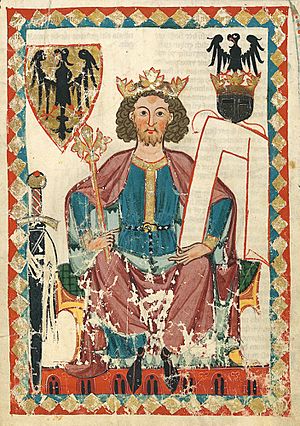
In the summer of 1195, Henry went back to Germany. He wanted to get support for his crusade. He also wanted to arrange who would rule after him if he died. First, he had to deal with problems in the Margraviate of Meissen. The margrave had died, and Henry took the chance to claim the land for himself.
In October, he made peace with an archbishop. He also got many nobles to support his crusade. The crusade was planned to start on Christmas 1196.
His next goal was to make the imperial crown hereditary. This meant that his son would automatically become emperor, not by election. Henry tried to get his son Frederick II elected King of the Romans. But the Archbishop of Cologne objected.
Henry and his officials developed the idea of a hereditary monarchy. The princes would lose their right to elect kings. But they would gain the right to pass on their own lands through their families, even to daughters. Henry agreed to these demands. The emperor also bought the support of church leaders. He promised to give up certain rights over church lands. At a meeting in Würzburg in March/April 1196, he convinced most princes to vote for his plan. However, the Archbishop of Cologne did not even show up. Several princes, especially in Saxony and Thuringia, were still unhappy.
In July 1196, Henry went to Burgundy and Italy. He wanted to talk with Pope Celestine III. But resistance in Germany grew. At a meeting in Erfurt in October, most princes rejected the emperor's plans. Also, the Pope, still worried about Henry's rule over Sicily, stopped the talks. Despite this, Henry's son Frederick II was elected King of the Romans in Frankfurt on Christmas.
Henry VI's Death
At the same time, the emperor was in Capua. There, he had a captured count cruelly executed. He entered Sicily in March 1197. He then focused on preparing his crusade in Messina.
Soon after, the foreign king's harsh rule caused a rebellion in Sicily. Henry's German soldiers put down the revolt without mercy. Even Queen Constance joined the rebels. She was upset by Henry's neglect and felt sorry for her people. She even besieged him in a castle, forcing him to make a treaty.
In the middle of his preparations, Henry got sick while hunting. He died on 28 September in Messina. He might have died from malaria, but some believe he was poisoned. His wife Constance buried him in Messina. In 1198, his body was moved to Palermo Cathedral. Some items from Henry VI's grave were removed in the late 1700s. These items, including parts of a shoe and a silk textile, are now in the British Museum in London.
Henry's young son, Frederick II, was supposed to inherit both Sicily and the Imperial crown. However, some princes elected Otto of Brunswick as anti-king. To protect his family's claims, Frederick's uncle, Philip of Swabia, had himself elected King of the Romans in March 1198. The German throne quarrel lasted for almost twenty years. Frederick was finally elected king again in 1212. Otto was defeated in a battle in 1214 and died in 1218.
Images for kids
-
Attributed coat of arms of Henry VI, Holy Roman Emperor (Codex Manesse)
-
Pope Celestine III crowning Henry VI. He was only crowned after promising to give up Tusculum.
See also
 In Spanish: Enrique VI del Sacro Imperio Romano Germánico para niños
In Spanish: Enrique VI del Sacro Imperio Romano Germánico para niños
- Family tree of German monarchs
- History of Swabian Sicily
Sources
- Alberic of Troisfontaines, Chronicon
- David Abulafia, Frederick II
|
Henry VI, Holy Roman Emperor
House of Hohenstaufen
Born: 1165 Died: 1197 |
||
| Regnal titles | ||
|---|---|---|
| Preceded by Frederick I |
King of Germany 1169–1197 |
Succeeded by Philip of Swabia & Otto IV |
| Holy Roman Emperor King of Italy 1191–1197 |
Succeeded by Otto IV |
|
| Preceded by William III |
King of Sicily with Constance 1194 –1197 |
Succeeded by Constance |


